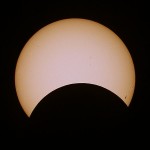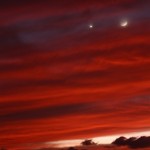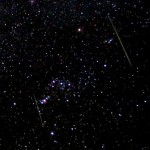Looking ahead to sharing a fun and pretty 2016 with everyone. As usual you can come to Darker View for heads up on everything happening in the sky for 2016. I have spent the last month setting up pre-scheduled posts with all of the significant sky events for the year. We have a couple interesting eclipses, including a total eclipse across the Pacific, and some nice conjunctions. Comet C/2013 US10 Catalina continues to be naked eye into January and C/2013 X1 PanSTARRS should be marginally naked eye in June.

The Moon
Below are tables of all of the new and full moons of 2016 for those who prefer to plan early for those observing outings. Eclipses are noted with an asterisk in the tables and are explored more fully in the following section.
For those who like supermoons you will have to wait for later in the year when the orbit and lunar phase align. November will be the best supermoon of the year when full moon occurs only two hours away from perigee on the 14th of the month. For a few months either side of the November full moon you will find perigee occurring within a day or two of full, allowing for larger and brighter than average full moons.
| Full Moons for 2016
|
||||
|---|---|---|---|---|
| UT | HST | |||
| January | Jan 24 | 01:46UT | Jan 23 | 15:46HST |
| February | Feb 22 | 18:20UT | Feb 22 | 08:20HST |
| March* | Mar 23 | 12:01UT | Mar 23 | 02:01HST |
| April | Apr 22 | 05:24UT | Apr 21 | 19:24HST |
| May | May 21 | 21:15UT | May 21 | 11:15HST |
| June | Jun 20 | 11:02UT | Jun 20 | 01:02HST |
| July | Jul 19 | 22:57UT | Jul 19 | 12:57HST |
| August | Aug 18 | 09:27UT | Aug 17 | 23:27HST |
| September* | Sep 16 | 19:05UT | Sep 16 | 09:05HST |
| October | Oct 16 | 04:23UT | Oct 15 | 18:23HST |
| November | Nov 14 | 13:52UT | Nov 14 | 03:52HST |
| December | Dec 14 | 00:05UT | Dec 13 | 14:05HST |
| *Lunar Eclipse | ||||
| New Moons for 2016
|
||||
|---|---|---|---|---|
| UT | HST | |||
| January | Jan 10 | 01:30UT | Jan 9 | 15:30HST |
| February | Feb 8 | 14:39UT | Feb 8 | 04:39HST |
| March* | Mar 9 | 01:54UT | Mar 8 | 15:54HST |
| April | Apr 7 | 11:24UT | Apr 7 | 01:24HST |
| May | May 6 | 19:30UT | May 6 | 09:30HST |
| June | Jun 5 | 03:00UT | Jun 4 | 17:00HST |
| July | Jul 4 | 11:01UT | Jul 4 | 01:01HST |
| August | Aug 2 | 20:45UT | Aug 2 | 10:45HST |
| Sep 01 | 09:03UT | Aug 31 | 23:03HST | |
| September* | Sep 31 | 00:12UT | Sep 30 | 14:12HST |
| October | Oct 30 | 17:38UT | Oct 30 | 07:38HST |
| November | Nov 29 | 12:18UT | Nov 29 | 02:18HST |
| December | Dec 29 | 06:53UT | Dec 28 | 20:53HST |
| *Solar Eclipse | ||||
For observers in the islands there are several nice opportunities to spot the young crescent Moon. On April 7th a 17 hour old Moon may be visible to the determined observer. The next opportunity for spotting a challenging young Moon is on December 29th when a 21 hour old moon may be visible given good conditions.

Eclipses
This year will feature a partial solar eclipse visible from Hawaii and an annular solar eclipse on the wrong side of the globe for island observers. There are also two minor penumbral lunar eclipses, one of which occurs over the Pacific.
The first solar eclipse of the year is a total solar eclipse that will cross much of the Pacific ocean on March 8th. Unfortunatly the line of totality passes well north of the main Hawaiian Islands, near Midway. For viewers in the islands this will be a good partial ranging from 55% for Hilo to 67% for Lihue. Photographers may find this eclipse interesting as the eclipse will occur with the Sun low in the late afternoon sky. Maximum eclipse will occur at about 17:36 HST, about and hour before local sunset at 18:31 HST.
The second solar eclipse of the year is an annular that occurs over Africa and the Indian Ocean. No part of this eclipse is visible from the Central Pacific.
A minor penumbral lunar eclipse will occur on March 23. This eclipse is technically visible from the islands, but as only a 0.77 magnitude penumbral eclipse you probably need an instrument to measure the lunar brightness change. The second lunar eclipse of the year, also a penumbral eclipse, occurs on September 16th and is not visible from the islands.
Seasons
Perihelion will occur on January 2nd in 2016, with apehelion on July 4th. Equinox and solstice dates are shown below. If you check these dates against last year you will note we have reset the drift of a quarter day each year as 2016 is a leap year. Last year the summer solstice was on June 21 at 16:38UT, this year it is on June 20 at 22:34UT.
| 2016 Solstices and Equinoxes
|
||||
|---|---|---|---|---|
| UT | HST | |||
| Perihelion | Jan 2 | 22:49UT | Jan 2 | 12:49HST |
| Vernal Equinox | Mar 20 | 04:30UT | Mar 19 | 18:30HST |
| Summer Solstice | Jun 20 | 22:34UT | Jun 20 | 12:34HST |
| Apehelion | Jul 4 | 16:24UT | Jul 4 | 06:24HST |
| Autumnal Equinox | Sep 22 | 14:21UT | Sep 22 | 04:21HST |
| Winter Solstice | Dec 21 | 10:44UT | Dec 21 | 00:44HST |
The Planets
We begin the year with almost all of the bright planets in the dawn sky. Early mornings reveal Venus and Jupiter high in the sky, while an astute observer will also spot Saturn and Mars. The only exception is Mercury, currently low in the evening sky after passing through maximum elongation on December 29th.
| Mercury Events for 2016
|
|||||
|---|---|---|---|---|---|
| Date UT | Separation | Magnitude | |||
| Morning | Feb 7 | 25.6°W | +0.2 | ||
| Evening | Apr 18 | 19.9°E | +0.4 | ||
| Morning | Jun 5 | 24.2°W | +0.7 | ||
| Evening | Aug 16 | 27.4°E | +0.6 | ||
| Morning | Sep 28 | 17.9°W | -0.2 | ||
| Evening | Dec 11 | 20.8°E | -0.2 | ||
There will be a transit of Mercury on May 9th, the first since 2006, almost a decade ago. The transit starts at 11:12UT, is at maximum at 14:57UT, and ends at 18:42UT. As such the transit will be past maximum at sunrise here in the islands. With sunrise occurring at 05:50HST we will only be able to observe the last hour of this event.
Venus will spend the first half of the year in the morning sky. It is currently setting into the dawn, having passed through maximum elongation back in October of 2015. Venus will pass through superior conjunction on June 6th to spend the last half of 2016 in the evening sky.
Mars will pass through opposition on May 22nd. At opposition the planet will have an angular size of 18.6″ making this event a somewhat decent opposition. At opposition the planet can range from around 14″ to 25″ in apparent size, greatly changing the visibility of surface detail to earthbound observers. The July 2018 opposition will be excellent with an apparent size of 24.3″. Mars will be nicely observable in the evening sky through the remainder of the year.
Jupiter is currently high in the morning sky and will see opposition on March 7th. This will place this interesting planet in the evening sky through the summer. The planet will slide into the Sunset in late August for solar conjunction on September 25th.
Saturn is currently rising in the morning sky and will be nicely visible throughout the summer with opposition occurring on June 2nd. With solar conjunction on December 10th the planet will be nicely placed in the evening sky for the last half of the year.

Conjunctions
As you would expect the year is well apportioned with the usual “Venus and Crescent Moon in the Sunset” sort of conjunctions. I have scheduled posts to alert the readers of DarkerView to the best of these pretty occurrences.
The highlight of the year is a set of conjunctions in the sunset that last from mid-August to mid-September. Mercury, Venus and Jupiter will all be present for the dance, with Venus and Jupiter passing within 12′ on August 27th. On September 2nd a thin crescent Moon will join the dance to place four bright objects within 8° of each other.
Other notable conjunctions of 2016 will include a close pass between Saturn and Venus, well under half a degree apart on January 8th and 9th. August 5th the Moon will pass within 40′ of Jupiter as seen from the islands.
Comets
We start the year with comet C/2013 US10 Catalina well placed for observation in the dawn sky. Currently approaching 6th magnitude the comet is marginally naked eye visible and an easy binocular target. The two tails are visible at widely diverging angles.
Comet C/2014 S2 PanSTARRS is currently visible at magnitude 8.5 in Draco, circumpolar for northern observers. The summer should see comet C/2013 X1 PanSTARRS approach 7th magnitude while well placed for observers in the northern hemisphere.
Of course there is always the possibility of a last minute discovery becoming a bright comet.

Meteor Showers
We start the year with the Quadrantid meteor shower peaking on the night of January 3rd. With a waning crescent moon this should be a good shower with a ZHR of about 120. Observers in Hawaii will have to wait until 01:30HST to start observations, observers further north should have a decent show all night long.
The Perseids should also present a good showing with a peak on the morning of August 12th. A waxing gibbous Moon will set at about 01:50 to leave the remainder of the morning for meteor watching.
The Geminids produced an excellent show in 2015, it is likely 2016 will be just as good. Unfortunately the Dec 13th full moon perfectly corresponds to the predicted peak of the shower.
The Lyrids, Orionids and Leonids are all predicted to be minor showers this year with ZHR’s of ten to twenty.
For complete details on this years meteor showers I suggest you read the International Meteor Organization’s 2016 shower calendar, always the best place for information. This is my source for the meteor information posted to DarkerView.

